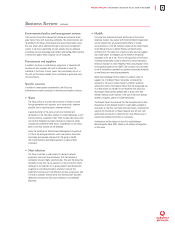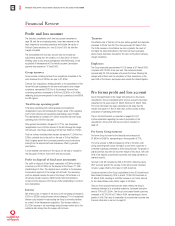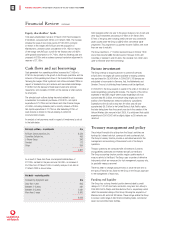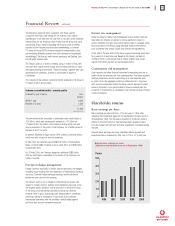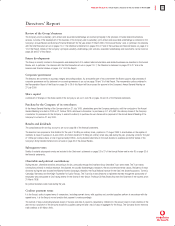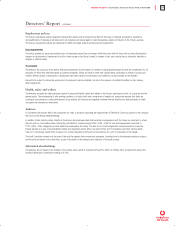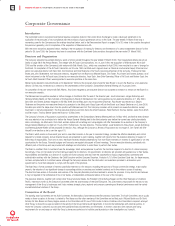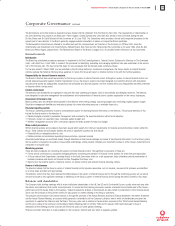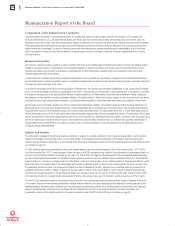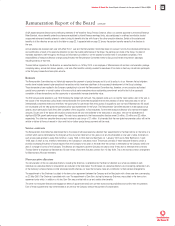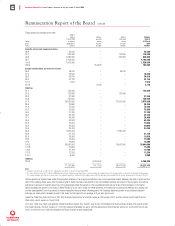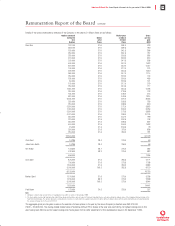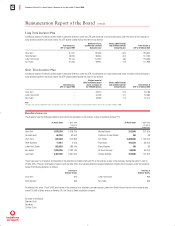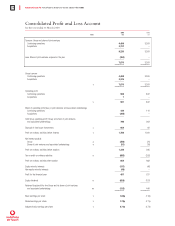Vodafone 2000 Annual Report Download - page 21
Download and view the complete annual report
Please find page 21 of the 2000 Vodafone annual report below. You can navigate through the pages in the report by either clicking on the pages listed below, or by using the keyword search tool below to find specific information within the annual report.
Vodafone AirTouch Plc Annual Report & Accounts for the year ended 31 March 2000 19
The Nominations Committee meets as required and was chaired until his retirement from the Board by Sam Ginn. The responsibility of chairmanship of
this Committee has now passed to Ian MacLaurin. Penny Hughes, Charles Schwab and Chris Gent also served on this Committee during the year.
Sir Alec Broers and Sir David Scholey left the Committee on 30 June 1999. The Committee, which provides a formal and transparent procedure for the
appointment of new directors to the Board, generally engages external consultants to advise on prospective Board appointees.
The Remuneration Committee was chaired by Ian MacLaurin until his re-appointment as Chairman of the Company on 23 May 2000, when the
Chairmanship was transferred to Sir David Scholey. Michael Boskin, Sam Ginn and Don Fisher joined this Committee on 30 June 1999, when Sir Alec
Broers and Penny Hughes stepped down. The Remuneration Report of the Board on pages 20 to 26 provides further information on this Committee.
Internal controls
Introduction
The Board has established procedures necessary to implement in full the Turnbull guidance, “Internal Control: Guidance for Directors on The Combined
Code”, with effect from 1 April 2000. A review of the processes for identifying, evaluating and managing significant risks was undertaken in the second
half of the financial year. This has formed the basis for new procedures that will be kept under continuous review.
For the year ended 31 March 2000, and as permitted by the UK Listing Authority’s transitional arrangements, the Group reports on internal financial
controls applying the Rutteman Working Group guidance. In future, the Group will report on internal controls in line with the Turnbull guidance.
Responsibility for internal financial controls
The Board of directors has overall responsibility for the Group’s system of internal financial control. Although no system of internal financial control can
provide absolute assurance against material misstatement or loss, the Group’s systems have been designed to provide the directors with reasonable
assurance that assets are safeguarded, transactions are authorised and recorded properly, and that material errors and irregularities are either prevented
or detected within a timely period.
Control environment
The directors have established an organisation structure with clear operating procedures, lines of responsibility and delegated authority. The directors
have delegated to executive management the establishment and implementation of financial control systems appropriate for the various businesses.
Assessment of business risk
Major business risks are identified and evaluated by the directors when setting strategy, approving budgets and monitoring progress against budget.
Subsidiary management identifies and evaluates business risks when allocating resources to minimise those risks.
Financial reporting system
The Group’s operating procedures include a comprehensive system for reporting financial information to the directors. The principal elements of this
include the formal review by the directors of:
• Detailed budgets prepared by subsidiary management and reviewed by the executive directors before formal adoption;
• Forecasts, revised on a quarterly basis, compared against budget; and
• Monthly management accounts with a comparison against the latest quarterly forecast and budget.
Main control procedures
Written financial policies and procedures have been issued which specify the minimum requirements for financial and administrative matters within the
Group. These policies and procedures address the areas of significant business risk and include:
• Financial limits on delegated authority; and
• Detailed policies and procedures regulating treasury activities, approved annually.
Associated undertakings are monitored closely through attendance at their board meetings and review of key financial information. It is the Group’s policy
that its auditors be appointed as auditors of associated undertakings, where possible. Detailed post investment reviews of all the Group’s investments are
conducted on a regular basis.
Monitoring process
There are clear procedures for monitoring the system of internal financial control. The significant components of these are:
• Formal annual confirmation by subsidiary managing directors concerning the operation of financial control systems for which they are responsible;
• A Group Internal Audit Department, reporting directly to the Audit Committee, which on a risk assessment basis undertakes periodic examination of
business processes and reports on financial controls throughout the Group; and
• Reports from the external auditors, Deloitte & Touche, on internal controls and relevant financial reporting matters.
Review of effectiveness
The directors believe that the Group’s system of internal financial control provides reasonable, but not absolute, assurance that problems are identified
on a timely basis and dealt with appropriately.
The directors confirm that they have reviewed the effectiveness of the system of internal financial control through the monitoring process set out above
and are not aware of any significant weakness or deficiency in the Group’s system of internal financial control during the period covered by this report.
Relations with shareholders
The Company holds briefing meetings with its major institutional shareholders in the UK, the US and in Continental Europe, usually twice each year after
the interim and preliminary final results’ announcements, to ensure that the investing community receives a balanced and complete view of the Group’s
performance and the issues faced by the business. Telecommunications analysts of stockbrokers are also invited to presentations of the financial results
and to visit the Company in the summer months for discussions on matters relating to the Group’s operations.
The principal communication with private investors is through the provision of the Annual Review & Summary Financial Statement, the Interim Statement
and the Annual General Meeting, an occasion which generally is attended by all the Company’s directors and at which all shareholders are given the
opportunity to question the Chairman and the Board. The proxy votes cast in relation to the resolutions proposed at the 1999 Annual General Meeting
and the proxy voting at the Company’s Extraordinary General Meetings held on 24 May 1999 and 24 January 2000 were disclosed to those in
attendance at the meetings and the Company will follow this policy at future general meetings.
Financial and other information is made available on the Company’s Internet web site, which is regularly updated.
Corporate Governance continued


